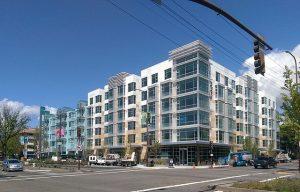
On Sunday the New York Times ran a story on the difficulties of building new housing in California, focusing on the city of Berkeley. There’s a lot of good in the piece, including the insane difficulties of getting approvals to build even when you propose something in keeping with the existing zoning.
But it misses a lot too. Firstly, it focuses on building more multifamily housing in existing single family neighborhoods. That seems to be the main lever it believes needs to be pulled to bring down housing costs. The idea that the Bay Area might build more housing on greenfield sites – single or multifamily – isn’t even contemplated. Nor does the piece cite examples of where large scale infill densification actually rendered housing affordable in the absence of new greenfield construction. I’m not aware of any such cases.
That’s not to say that upzoning or densification are a bad things. I would support upzoning and building more infill in nodes proximate to transit stations. (I also think we should be honest that our intent in this is in fact to change the character of the neighborhood). But if you’re taking urbanized area expansion off the table, don’t ever expect to bring housing prices down materially.
The focus of these kinds of stories usually seem to be places like Berkeley, or San Francisco or Palo Alto or New York City. But these are special places. It’s not realistic to think you could ever build enough housing to accommodate the demand to live in them. Keep in mind that if prices fell by 50% in San Francisco, which would still be high, massive numbers of new people would contemplate moving there. The housing crisis has to be solved primarily through building more workaday communities, not elite ones.
Also, the piece fails to note the role of various building regulations, impact fees, lawsuits, etc. in driving up the price to construct housing. The San Diego Union Tribune recently had a piece on housing prices in that city that details some of these. (They also note that about half of San Diego County land is off-limits to building, including some zoned for agricultural use only).
Lastly, I find it interesting that many of the same kind of people who complain about state preemption in other contexts are very happy to see the state of California disempowering localities to make land use decisions (a core function of local government).
In short, yes, we need to make it easier to build in existing neighborhoods and we need to allow increased density in some locations. But we shouldn’t pretend that building more apartments in the Berkeleys of this world will bring Bay Area housing prices down to affordable levels absent greenfield development (or a collapse in demand).
This piece originally appeared on Urbanophile.
Aaron M. Renn is a senior fellow at the Manhattan Institute, a contributing editor of City Journal, and an economic development columnist for Governing magazine. He focuses on ways to help America’s cities thrive in an ever more complex, competitive, globalized, and diverse twenty-first century. During Renn’s 15-year career in management and technology consulting, he was a partner at Accenture and held several technology strategy roles and directed multimillion-dollar global technology implementations. He has contributed to The Guardian, Forbes.com, and numerous other publications. Renn holds a B.S. from Indiana University, where he coauthored an early social-networking platform in 1991.
Photo: Alfred Twu













Plan Bay Area
ABAG (Assoc of Bay Area Governments) adopted the Plan Bay Area a few years back, a supposedly coordinated housing plan for the entire Bay Area. It envisions that most new housing will be built in the current urban centers with quotas allocated accordingly, with the outlying counties more or less let off the hook. Furthermore, over half of new housing is planned to be deed restricted affordable units, mostly in multiunit developments. Presumably the largest part of the market rate units will likewise be in such multiunit developments.
So, what ABAG envisions is that new homeowners will largely live in apartments or condos, whether deed restricted or market rate (unless they're lucky enough to inherit well or win with stock options). All the pressures are there to continue to drive single family home values upwards.